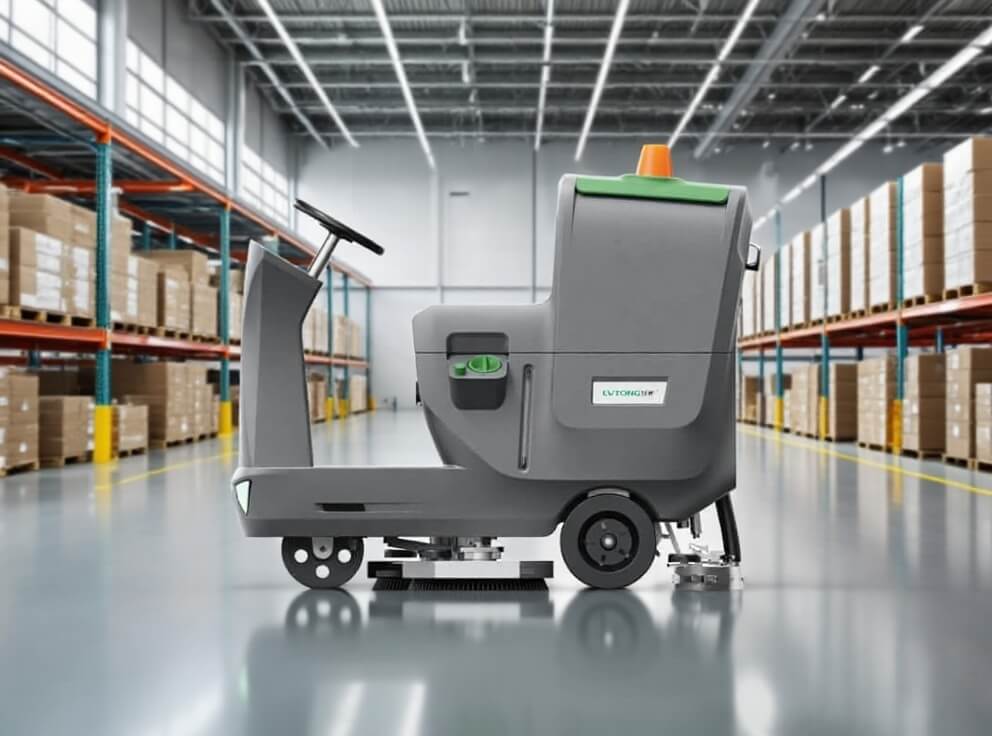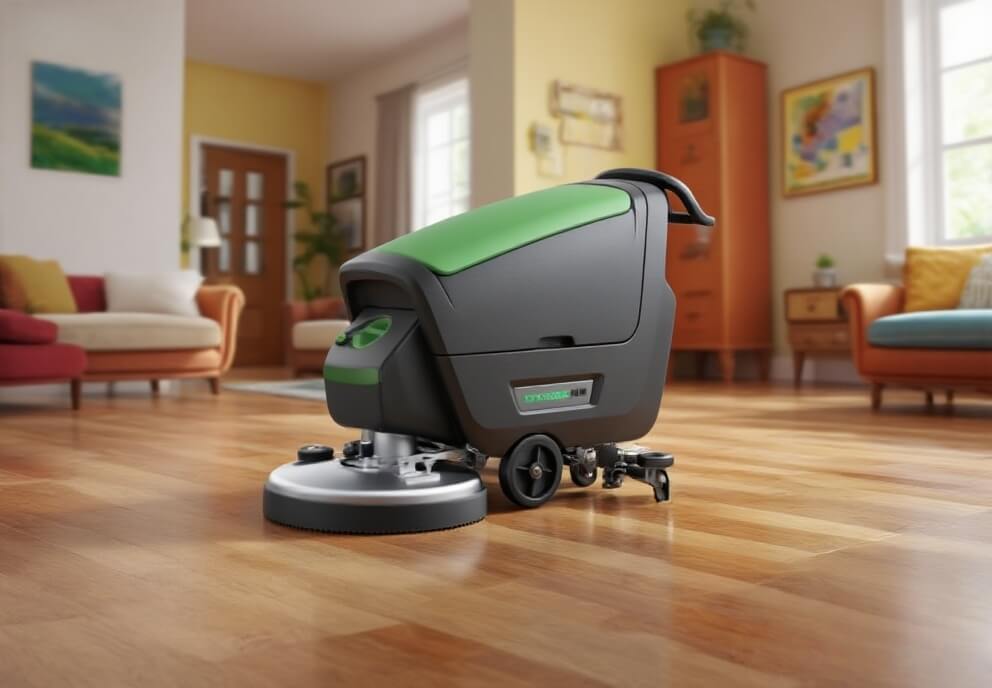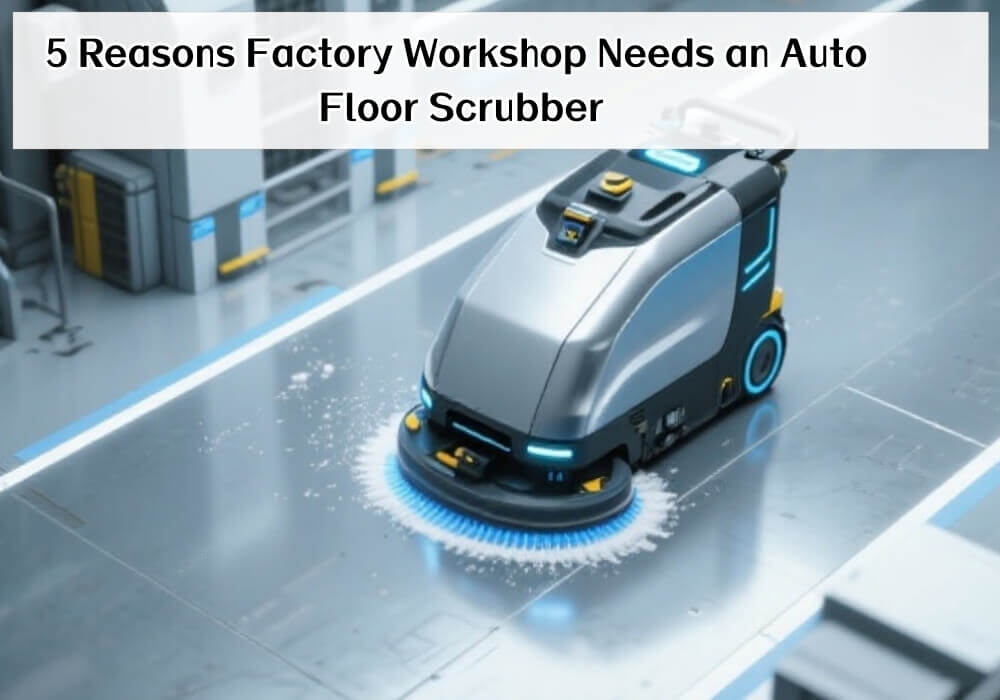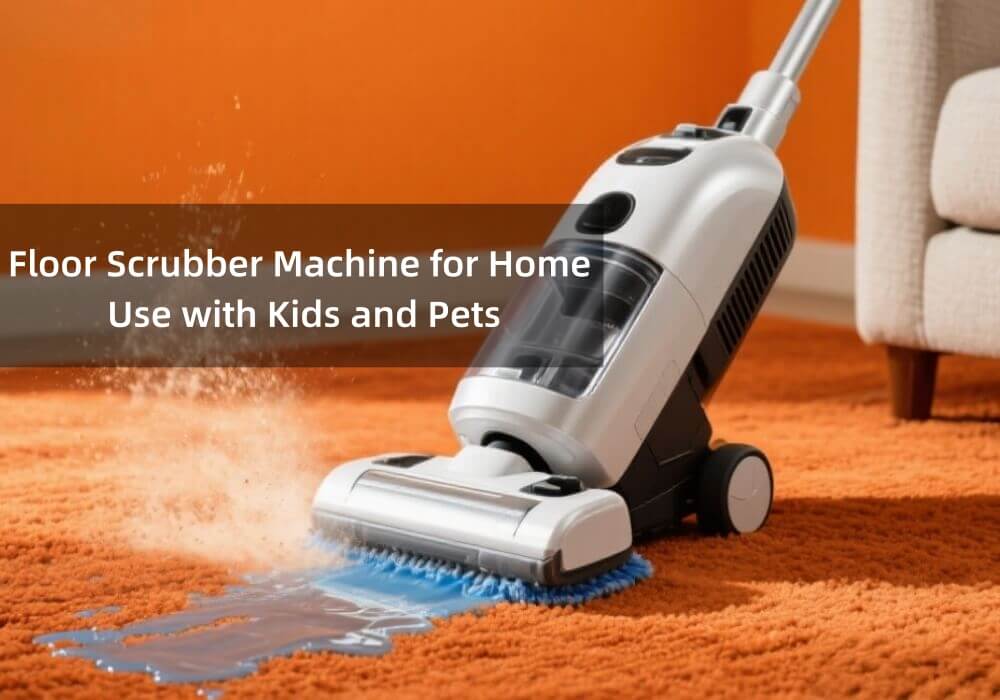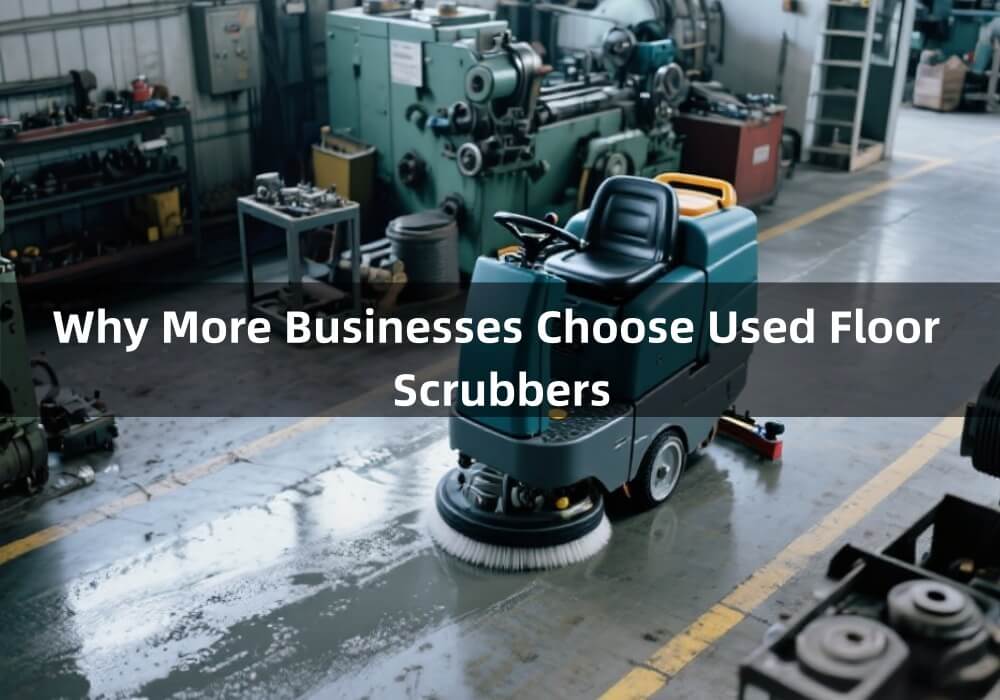Introduction
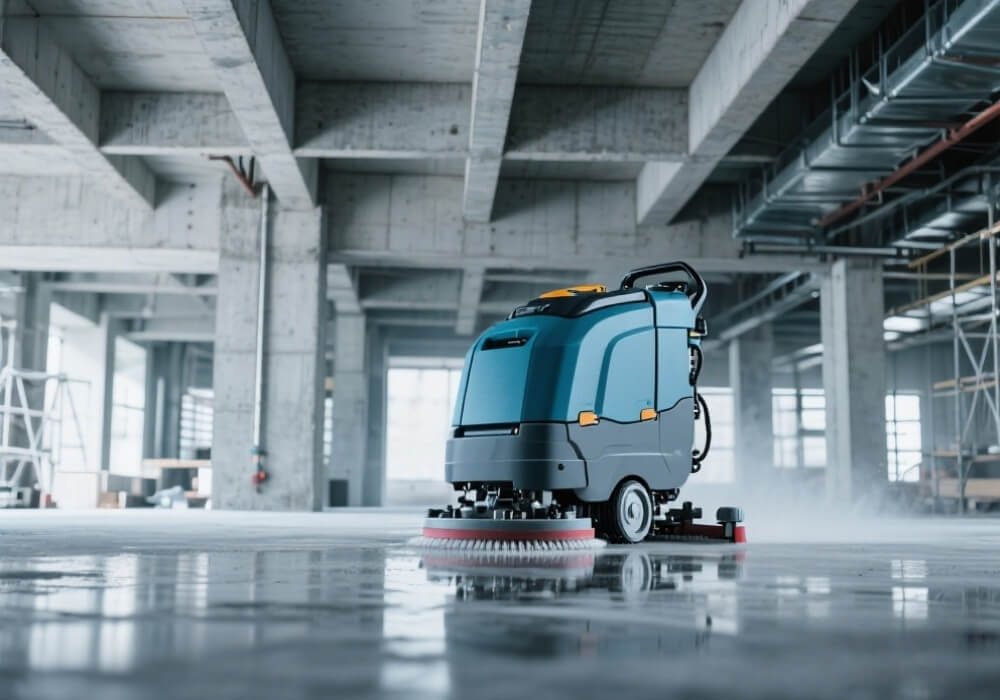
In industrial production scenarios, concrete floors, due to their high strength, high wear resistance, and low cost, have become the preferred flooring material for areas such as factory workshops, logistics warehouses, large supermarkets, and parking lots. However, over long-term use, concrete floors are prone to accumulating pollutants such as oil, dust, metal debris, and chemical residues. This not only affects the cleanliness of the workshop environment but can also cause slippery floors, equipment wear, and personnel accidents.
As professional cleaning equipment, industrial floor scrubbers can effectively address the pain points of concrete floor cleaning. This article will explain the important role industrial floor scrubbers play in cleaning concrete floors, combining the contamination characteristics of concrete, the features of floor scrubbers, and cleaning procedures.
Concrete Floor Characteristics & Contamination Types
Before using an industrial scrubber, it is important to understand the material properties of the concrete and the type of contamination.
Core Features
Concrete floors are cast using a proportional mixture of cement, sand, and water. Depending on the surface treatment, they can be categorized as plain concrete, corundum-coated concrete, sealant-curing concrete, and epoxy-coated concrete.
Surface Hardness: The surface hardness of ordinary plain concrete is relatively low (3-4 Levels Mohs hardness); The concrete after sealing and curing has a high hardness (8-9 levels), and has strong wear resistance and impermeability.
Surface Flatness: Concrete floors often have minor cracks, differences in joint height, and localized sanding problems. If the floor scrubber brush plate doesn't adhere well to the ground, it can easily lead to residual pollutants in the gaps.
Permeability: Ordinary concrete has numerous micropores, allowing oil, dirt, and chemicals to penetrate easily, which is making it difficult to clean. Conversely, sealed, cured concrete fills its surface pores, significantly reducing permeability. It allows contaminants to adhere to the surface and is making cleaning easier.
Type of pollution
In different industries, Concrete floors have different levels of contaminants and require specific cleaning solutions.
Pollution Type | Scenarios | Pollution Characteristics | Cleaning Difficulties |
Dust | Mechanical processing workshop, flour mill | Mainly metal debris, cement dust, and flour particles | A lot of dust, and manual cleaning is prone to secondary pollution |
Oil | Auto repair shops, Food processing plants | Divided into mineral oil (motor oil, lubricating oil), Animal and vegetable oil (edible oil, grease), mostly in liquid or semi-solid state | With strong adhesion to the ground and difficult to dissolve with ordinary water |
Chemical Residues | Electronics factories, chemical plants, laboratories | Mainly acid and alkali solutions, solvents, and heavy metal ions | If not cleaned in time, it may damage the floor structure |
Mixed | Logistics parks, large supermarkets | Dust, oil, footprints, water stains, complex pollution components | A single cleaning method is difficult to completely solve |
Industrial Floor Scrubber Selection and Preparation
Different types of industrial floor scrubbers have different cleaning effects. Before choosing a floor scrubber for concrete floors, it is necessary to scientifically select a model and make preparations for cleaning based on factors such as the area of the concrete floor, the type of contamination, and the application restrictions.
Industrial Floor Scrubber Types
Industrial floor scrubbers are primarily divided into two categories: walk-behind floor scrubbers and ride-on floor scrubbers. These differ significantly in cleaning efficiency, applicable scenarios, and operational difficulty. Choosing the right one depends on your specific needs.
Selection Dimensions | Walk-behind Floor Scrubber | Ride-on Floor Scrubber |
Applicable Area | 500-3000㎡/day | 3000-20000㎡/day |
Core Advantages | Small size, high flexibility, can clean narrow channels, low purchase cost | High cleaning efficiency, saving manpower; large cleaning area, easy to operate |
Scenarios | Small workshops, equipment-intensive areas, warehouse passages, elevator rooms | Large factories, logistics warehouses, parking lots, large supermarkets |
Parameters | Brush plate width (commonly 500-600mm), squeegee width (slightly larger than brush plate width), water tank capacity (40-80L) | Brush width (800-1200mm), squeegee width (1000-1500mm), water tank capacity (100-300L), battery life (4-8 hours) |
Brush Plate Type
- Nylon Brush: Soft bristles, suitable for general dust and lightly soiled concrete floors.
- Wire Brush: Suitable for stubborn stains and heavy metal debris.
- Scrubber Pad Brush: Suitable for heavy oil and chemical residue.
Pre-cleaning Preparation
On-site Observation:
- Clearing Large Obstacles: Discarded cardboard boxes, metal waste, equipment and components.
- Mark Hazardous Areas: If there are obstacles such as uncured concrete or sharp metal on the ground, they need to be marked with warning lines to prevent damage to the floor scrubber.
- Check the Ground Condition: Record the cracks, sanding, and oil penetration locations on the ground, which need to be addressed during subsequent cleaning
Equipment Inspection:
- Appearance Inspection: Check the brush, squeegee, and machine body for electrical or water leaks.
- Functional Inspection: Test the brush speed, suction motor suction, and instrument panel display.
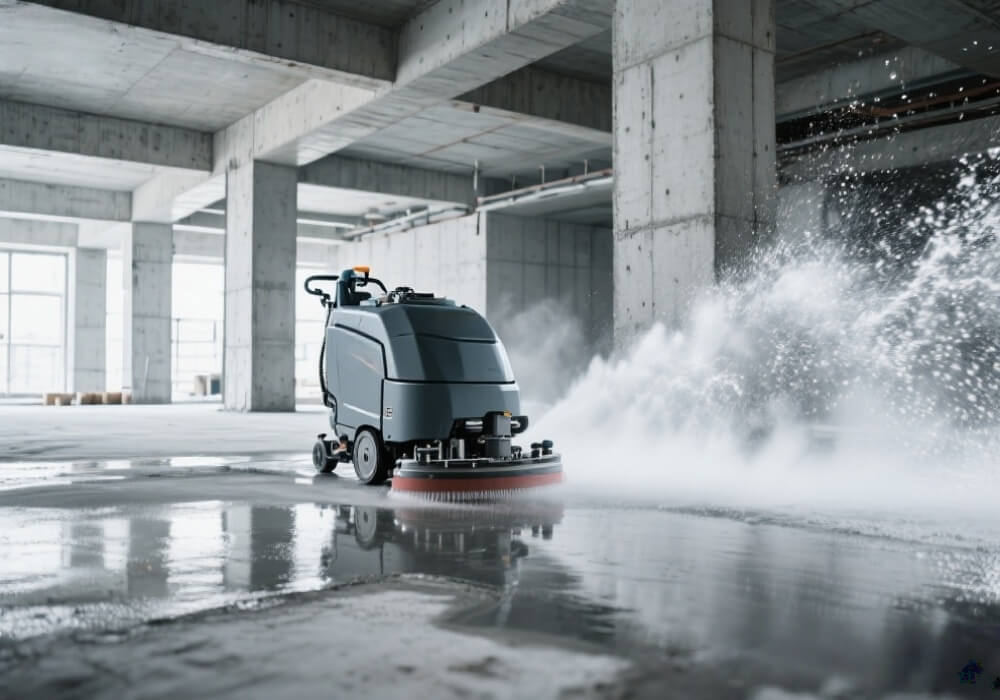
Core Cleaning Steps
Different concrete floors are with different operational details.
Pretreatment
Oil Pollution Pretreatment:
- Liquid Floating Oil: First, use an oil absorbing cotton or mop to absorb the surface floating oil, avoiding the spread of oil stains during floor cleaning
- Solid or Penetrating Oil Stains: Spray oil stain cleaner on the surface of the oil stain, use a hard bristled brush to scrub areas with severe oil stains, and destroy the adhesion between the oil stain and the ground
Chemical Residue Treatment:
- Acidic Residue: Spray alkaline neutralizing agent on contaminated areas to neutralize residual acidic substances
- Alkaline Residue: Spray acidic neutralizing agent on the surface of the chemical, wait for neutralization, and rinse the area with clean water
Dust Treatment:
- Metal Debris, Sand and Gravel: Use an industrial vacuum cleaner or sweeping machine to clean first, to avoid debris entering the floor scrubber brush disc, causing wear on the brush disc or pipe blockage
- Fine Dust: First, use a floor scrubber to absorb surface dust in dry suction mode, and then perform wet mopping cleaning.
Cleaning the Scrubber's Main Body
Zone Division
- Cleaning Area: Divide the concrete floor into several independent areas and follow the cleaning order of "from inside to outside, left to right, dry area first and then wet area".
Operation Tips
- Straight Line Cleaning: Push the floor scrubber at a constant speed along the long side of the area to ensure that the brush tray completely covers the ground and avoids missing brushes. Adjacent cleaning paths overlap by 5-10cm to prevent cleaning gaps.
- Turning Operation: When turning a walk behind floor scrubber, slowly adjust the direction to avoid sudden turns that may cause the brush disc to detach from the ground; When turning a ride on floor scrubber, slow down in advance and drive around a big bend to prevent it from absorbing water and scraping against the ground or obstacles.
- Gap and Corner Treatment: For corners of the wall or gaps at the bottom of the equipment that cannot be covered by the floor scrubber (width ≤ 10cm). Firstly, using a small handheld cleaning brush (such as a toothbrush or small brush) to manually scrub, and then use the floor scrubber to absorb water and scrape close to the gaps to remove sewage.
- Sewage Tank Monitoring: During the cleaning process, check the water level of the sewage tank every 15-20 minutes. If the capacity of the sewage tank reaches 80%, stop cleaning immediately, dump the sewage and flush the sewage tank.
Cleaning Differences of Different Concrete Floors
- Ordinary Floor Concrete: Choose a nylon brush, adjust the brush pressure to 15-20kg, and spray a moderate amount of water to avoid long-term water accumulation on the ground that causes sanding.
- Sealed Cured Concrete: Choose a nylon brush disc or scouring pad brush disc, adjust the pressure of the brush disc to 20-25kg, and slightly reduce the amount of water sprayed.
- Diamond Sand Concrete: Use wire brush discs or nylon brush discs, adjust the brush disc pressure to 25-30kg, suitable for cleaning scenes with a lot of metal debris.
- Epoxy Resin-Faced Concrete: Only use nylon brushes or scouring pad brushes. The brush pressure should be≤15kg to prevent excessive pressure from causing wear of the coating.
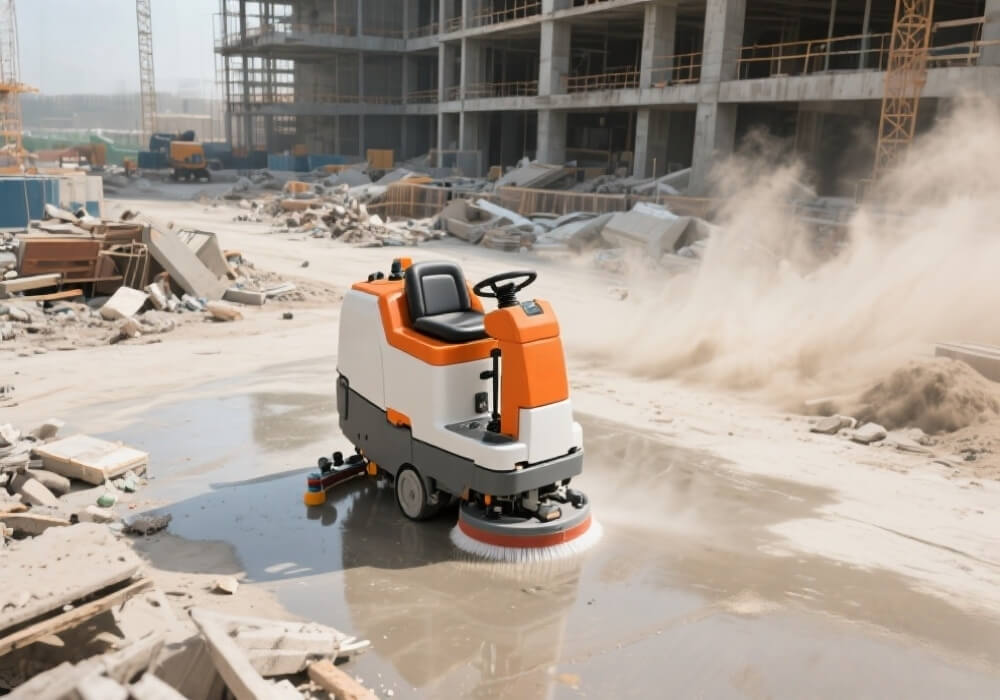
Finishing Work
Finishing work is an important part of ensuring cleaning quality and extending equipment life.
Ground Inspection
- Visual Inspection: Observe whether there are residual stains, water stains, and dust on the ground; Focus on inspecting corners such as wall corners, equipment bottoms, and ground joints
- Drying Inspection: Use a tissue to wipe the floor. If there are no obvious water stains on the tissue, it indicates that the water absorption effect meets the standard
- Safety Check: Ensure that there is no risk of slipping on the cleaned floor
Equipment Arrangement
- Turn off Machines: Follow the sequence of "turn off the brush plate first → water spray→motor→main power" to avoid equipment failure caused by turning off the power directly
- Equipment Cleaning: Remove the brush disc, rinse the dirt on the brush disc with clean water, clean the absorbent rubber strip, clean water tank, sewage tank and other accessories.
- Equipment Placement: Place the floor scrubber in a dry and ventilated warehouse; If the equipment is not used for a long time, the water tank should be emptied, fully charged, and covered with a dust cover.
Common Problems and Solutions
Based on the investigation and analysis, the following are common problems and corresponding solutions for cleaning concrete floors.
Cleaning Effectiveness Issue
FAQ | Causes | Solutions |
There is still dust on the ground | Incomplete pretreatment; Insufficient brushing pressure | 1. Use a vacuum cleaner to absorb surface dust first, then use a floor scrubber to clean; 2. Increase the brush pressure; 3. Adjust the squeegee height |
Oil stains still remain after cleaning | 1. The detergent concentration is too low or the cleaning time is insufficient; 2. The brush type is not selected properly | 1. With too low detergent concentration or insufficient cleaning time 2. The brush type is not selected properly |
Water stains on the ground | 1. Excessive water spraying and slow water suction 2. Insufficient suction power from the suction motor 3. The wastewater tank is full or the pipe is clogged | 1. Vacuum the surface first, then clean with a floor scrubber. 2. Increase the brush pressure 3. Adjust the squeegee height |
Ground Damage Issue
FAQ | Causes | Solution |
Scratches on the Ground | 1. Wrong brush type selected 2. Excessive brush pressure | 1. Replace the brush with a nylon brush and avoid using a wire brush 2. Reduce the brush pressure |
Ground sanding intensifies | 1. Excessive brush pressure damages the floor surface 2. Using strong acid or alkaline cleaners corrodes the floor | 1. Reduce the amount of water sprayed and vacuum up any remaining wastewater immediately after cleaning 2. Reduce the pressure on the brush 3. Use a neutral detergent |
Ground discoloration | 1. Chemical residue causing corrosion and discoloration of the floor 2. Excessive detergent concentration 3. Prolonged contamination of the floor by wastewater | 1. Re-treat the area with chemical residue using a neutralizer, then rinse with clean water 2. Dilute the cleaning agent in the correct proportion 3. Vacuum up the remaining wastewater promptly |
Routine Maintenance of Concrete Floors
Regular Sealing Treatment: For ordinary plain concrete or corundum concrete, it is recommended to perform sealing and curing treatment once every 1-2 years. It can improve surface hardness, impermeability and reduce oil and dust penetration.
Avoid Heavy Object Impact: It is strictly prohibited to drag heavy equipment on concrete floors and damage the ground.
Timely Cleaning of Pollutants: When oil stains or chemical liquid leaks are found on the ground, they need to be dealt with in a timely manner.
Avoid Damp Floors: Make sure the floor is completely dry after cleaning.
Conclusion
As an efficient tool for cleaning concrete floors, the correct use of industrial floor scrubbers is not only related to the cleaning effect, but also directly affects the equipment life and operating costs. After in-depth understanding of the cleaning equipment principles, operation methods, equipment maintenance and concrete floor characteristics, it can help users improve the use of industrial floor scrubbers more comprehensively and achieve more efficient, economical and safer concrete floor cleaning operations.

